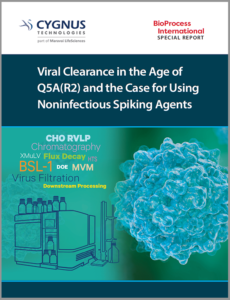- Sponsored Content
- Chromatography
- Fill/Finish
- Laboratory Equipment
Viral Clearance in the Age of Q5A(R2) and the Case for Using Noninfectious Spiking Agents
Sponsored by Cygnus Technologies
 As viruses can arise during the manufacture of biopharmaceuticals, regulatory agencies require “viral clearance” validation studies for each biopharmaceutical prior to approval. For example, Type C Retrovirus-Like Particles (RVLP) are endogenously produced during CHO cell expression. As such, regulatory agencies require proof that downstream process steps can effectively remove or inactivate retrovirus. A model mammalian virus, Xenotropic Murine Leukemia Virus (XMuLV) is typically used to demonstrate RVLP clearance. However, the establishment of RVLP quantification methods has made it possible to track the removal of actual endogenous RVLP throughout the downstream process. Additionally, the recent draft of ICH Q5A revision states that, “For CHO cell-derived products, CHO-derived endogenous virus particles (RVLP) can also be used for viral clearance experiments.”
As viruses can arise during the manufacture of biopharmaceuticals, regulatory agencies require “viral clearance” validation studies for each biopharmaceutical prior to approval. For example, Type C Retrovirus-Like Particles (RVLP) are endogenously produced during CHO cell expression. As such, regulatory agencies require proof that downstream process steps can effectively remove or inactivate retrovirus. A model mammalian virus, Xenotropic Murine Leukemia Virus (XMuLV) is typically used to demonstrate RVLP clearance. However, the establishment of RVLP quantification methods has made it possible to track the removal of actual endogenous RVLP throughout the downstream process. Additionally, the recent draft of ICH Q5A revision states that, “For CHO cell-derived products, CHO-derived endogenous virus particles (RVLP) can also be used for viral clearance experiments.”
In this Special Report, you will learn more about the use of a BSL-1 compatible, non-infectious RVLP and MVM particles to predict viral clearance results over a wide variety of process development applications, including Protein A, virus filtration, CEX, AEX, high throughput chromatography resin screening as well as a facile method of inactivating and quantifying the detergent inactivation of RVLPs.
Fill out the form below to read the full special report from Cygnus Technologies.
You May Also Like





